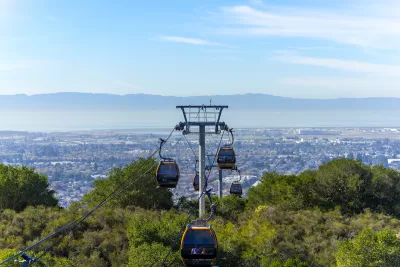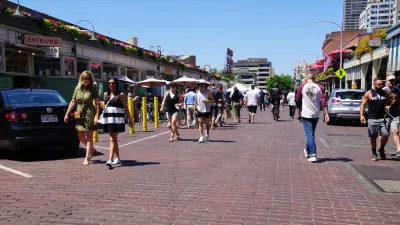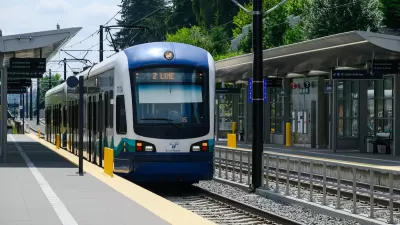While often thought of as only for tourists in mountain areas, aerial cable cars have proven to be effective in providing transportation in urban areas, such as across rivers in New York City and freeways in Portland.

I have always thought that certain public transport modes were underutilized, at least in the U.S. One of them is the aerial cable car or aerial tramway. I have ridden several in Italy, Germany, Barcelona, and the U.S., and can attest to their functionality as well as being just plain fun to ride. As a transportation consumer, I wish they were more prevalent. As a transportation planner, I know this won't happen until they are at least considered an option and routinely included in feasibility analyses for providing improved transportation to a site, as are roads, roadway bridges, and parking garages.
This matters because otherwise, we will continue on the same unsustainable knee-jerk American practice of building more roads, road bridges, and parking garages, despite the fact that ample case studies have proven that aerial cable cars can serve residents just as well (or better) in certain contexts. One local (to me) success story was the Oakland California Zoo's choice to use aerial gondolas instead of a stream of buses to transport visitors to the expansion of the zoo to a more remote part of the property. A local missed opportunity was the relocated Chabot Space and Science Center in the Oakland Hills, which included the construction of a large parking garage. The “mitigation” of bus service to the site only lasted about two years. Now, 20 years later, the only way to get there is to drive, the nearest bus stop being 1.2 miles away, and the walk being along a narrow winding road with no sidewalks and no shoulders. There should have been at least a cost comparison of the parking garage versus an aerial cable car, which would also have provided a transit option to the many hiking trails that are adjacent to the center.
Historic and recent experience has proven that aerial trams and gondolas do indeed attract riders, not only for transport purposes but also just for the fun and the views. Recent news has also made us aware how essential they are in providing transport in certain areas of the world, such as in Pakistan, where hundreds of school children and their teachers rely on aerial cable cars for transportation between villages in the mountainous areas. This shows that nonurban as well as urban areas need transport options beyond automobiles. A recent New York Times article noted that in Vietnam, aerial cable cars are being built both as a form of transport and also as an economic development instrument. (See: If You Can Take the Cable Car to the Colosseum, You’re in Vietnam, October 25, 2023).
Volume 28.2 November 2023
We are pleased to announce that the Fall issue of World Transport Policy and Practice is devoted to aerial cable cars as a form of urban transportation. Check out volume 28.2 here.
This issue presents articles on aerial cable cars' advantages and disadvantages and describes their success in La Paz, Bolivia. This issue contains two case studies of potential applications, one in the USA and one in Africa. Finally there is an article on how combining aerial gondola technology with autonomous vehicle technology could expand their application in urban areas.
We invite you to check out issue 28.2 and prior issues here and to consider submitting your own stories of policies and practices that have moved your community to implement—and embrace—sustainable transportation. In addition we are always looking to promote insightful books and useful resources, so we are accepting book reviews and announcements of new plans and guidelines that shift the focus from car-oriented transportation to modes that support livable cities.
Support our Mission
Though the journal is free, there are, of course, expenses incurred to ensure a high quality, graphically engaging journal on an open platform; we rely on contributions from generous donors, and welcome all who can to contribute. Please consider becoming a sponsor. Our supporters enable us to continue our 26+ year tradition as a freely accessible journal of practical ideas and examples for building communities based on sustainable transportation. Donations can be made via credit card via our website here.

Alabama: Trump Terminates Settlements for Black Communities Harmed By Raw Sewage
Trump deemed the landmark civil rights agreement “illegal DEI and environmental justice policy.”

Planetizen Federal Action Tracker
A weekly monitor of how Trump’s orders and actions are impacting planners and planning in America.

The 120 Year Old Tiny Home Villages That Sheltered San Francisco’s Earthquake Refugees
More than a century ago, San Francisco mobilized to house thousands of residents displaced by the 1906 earthquake. Could their strategy offer a model for the present?

In Both Crashes and Crime, Public Transportation is Far Safer than Driving
Contrary to popular assumptions, public transportation has far lower crash and crime rates than automobile travel. For safer communities, improve and encourage transit travel.

Report: Zoning Reforms Should Complement Nashville’s Ambitious Transit Plan
Without reform, restrictive zoning codes will limit the impact of the city’s planned transit expansion and could exclude some of the residents who depend on transit the most.

Judge Orders Release of Frozen IRA, IIJA Funding
The decision is a victory for environmental groups who charged that freezing funds for critical infrastructure and disaster response programs caused “real and irreparable harm” to communities.
Urban Design for Planners 1: Software Tools
This six-course series explores essential urban design concepts using open source software and equips planners with the tools they need to participate fully in the urban design process.
Planning for Universal Design
Learn the tools for implementing Universal Design in planning regulations.
Clanton & Associates, Inc.
Jessamine County Fiscal Court
Institute for Housing and Urban Development Studies (IHS)
City of Grandview
Harvard GSD Executive Education
Toledo-Lucas County Plan Commissions
Salt Lake City
NYU Wagner Graduate School of Public Service






























